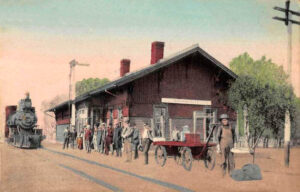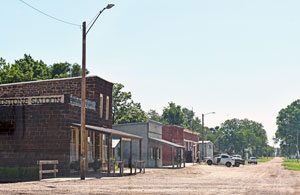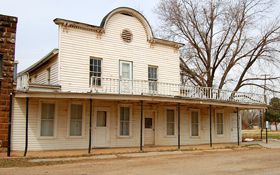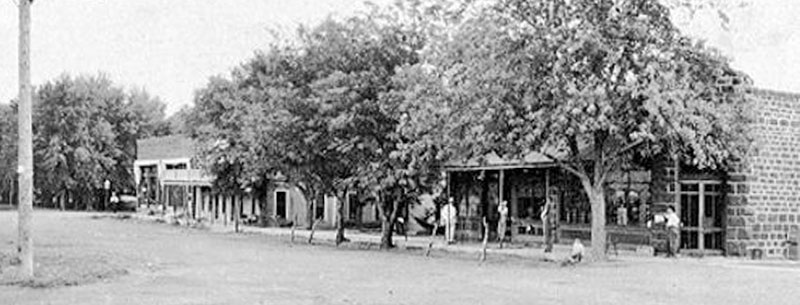
Early-day Brookville, Kansas.
Another Kansas cowtown, Brookville got its start when the tracks of the Kansas Pacific Railroad reached the area in 1867. Located about 15 miles southwest of Salina, its first settler was a man named John Crittenden. The first buildings erected in the town were the roundhouse and shops of the Kansas Pacific Railroad.
That very first year, Brookville was attacked by Indians. Angered by the railroad pushing west into their hunting grounds, a large group of warriors converged upon the town. Taking refuge, the townsfolk escaped to the roundhouse, where a barricade was hastily thrown up.
The Indians then surrounded the building, piled railroad ties against it, and tried to set the structure on fire. However, the quick-thinking railroad crew jumped on a steam engine and ran it through the roundhouse doors, startling the Indians, who quickly fled. The railroad crew then headed for Salina for help. When they arrived, a dead Indian was found caught on a wheel of the train.
Two years later, the Kansas Pacific Railroad, intending to make the town a major shipping point, officially surveyed and laid out the townsite in April 1870. The main street ran roughly east-west, parallel to the railroad tracks. The first house was built by M. P. Wyman, and the first store was established by George Snyder. A post office was established on February 2, 1870.
The settlement grew quickly, and in June 1870, the limits were enlarged by adding a small addition, and in September, yet another larger addition was added. The town grew so rapidly that it was incorporated as a city of the third class, with William Brownhill as its first mayor. Numerous businesses sprang up, including three hotels, one of which was the Brookville Hotel, whose restaurant, first called the Cowtown Café, would do business for more than a century in Brookville.
For a time, Brookville was the last station west of Salina on the Kansas Pacific Railway, making it an important shipping point as cattle were driven northward from Indian Territory and Texas along the Chisholm Trail to be loaded on freight cars headed east. Because the railroad had granted the right-of-way for the townsite, it tried to impose a law that prohibited liquor in the city limits. This, however, failed, as saloonkeepers violated the restriction in order to serve the thirsty cowboys.
Brookville was incorporated as a city of the third class in 1873 with William Brownhill as the first mayor.
In December 1874, a lawless event occurred that horrified the entire community. Two local brothers, by the names of William and Thomas Anderson, were in a saloon owned by a man named Barney Bohan. When an altercation took place between Bohan and the Anderson brothers, it ended with the Andersons dead on the floor. The citizens, excited over the double murders of the local boys, quickly began to make threats of lynching. Bohan was then quickly taken to Salina and placed in jail. There, too, citizens wanted to lynch the killer and converged on the jail with ropes. However, the sheriff had gotten word of the attempt and took the necessary steps to prevent the prisoner from being taken from the jail. Bohan was later tried for the murder of William Anderson and convicted, but an appeal was taken to the Supreme Court, where the case was reversed. He was next placed upon trial for the murder of Thomas Anderson, found guilty and convicted. He was sentenced to the Kansas State Penitentiary for life, but after being there about four years he went insane and was sent to the State Insane Asylum.
During the 1870s, Brookville peaked with a population of about 800 people. During this time, the town boasted four general merchandise stores, a furniture store, hardware store, jewelry store, a millinery, wagon shop, boot, and shoe store, a drug store, a tobacco store, one elevator, a restaurant, a flour mill, two hotels, a livery stable, and two lumberyards
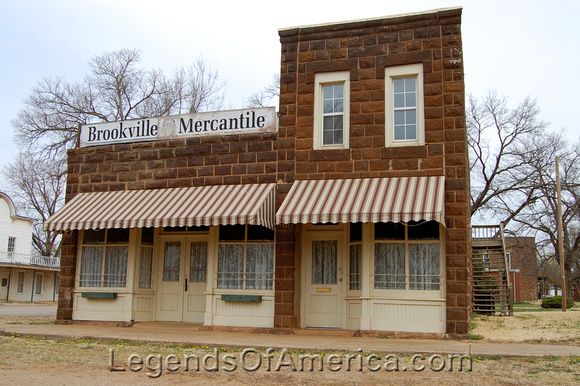
The old Brookville Mercantile in 2009. It has since been restored and is now the Sandstone Saloon. Photo by Kathy Alexander.
The Brookville Transcript was first published in November 1879 by Albin & Tupper. At that time, the town also boasted a Methodist Church.
In 1880, the two-and-a half story brown sandstone Brookville Grade School was built. A basement beneath the the schoolhouse served at various times as classroom and lunch room space. The school was also used to house community events.
“The pride and joy of that beautiful little city… a model of good taste and convenience in its arrangements. The four large, cheerful, and well-ventilated rooms were handsomely finished with pictures on the walls.”
— Saline County Journal describing the school, March 18, 1880
In the early 1880’s Brookville was booming. It had a population of 600 and boasted four general stores, a furniture store, a hardware store, a restaurant, a flour mill, and two hotels.
However, in the next years, Brookville’s heydays began to decline. When the railroad relocated its roundhouse to Junction City in 1889, it nearly spelled a death knell for the city. By the turn of the century, Brookville was called home to only about 280 people, but still supported a bank, a newspaper, a post office, and a few businesses. The Brookville Hotel was purchased in 1894 by Gus and Mae Magnuson and gained a well-earned reputation for its great food.
Over the next century, Brookville maintained its small-town lifestyle, with its population ebbing and flowing, sometimes nearly becoming a total ghost town. Despite its decline, one business continued to hang on – the Brookville Hotel restaurant.
In 1910, Brookville was on the Union Pacific Railroad and had a bank, a newspaper, telegraph and express offices, a money order postoffice with two rural routes, and a ppulation of 280.
In 1915, Gus and Mae Magnuson’s daughter, Helen Martin, originated the famous family-style chicken dinners at the Brookville Hotel. It was these dinners that drew large crowds to the restaurant from miles around.The hotel passed into her hands in 1933 and during World War II, it became even more famous as thousands of soldiers traveled from nearby Camp Phillips and the Smoky Hill Air Base. But when the war ended and Interstate Highways I-70 and I-35 were built near Salina, the town went into decline again. Still, the Brookville Hotel Restaurant hung on to at least 2000.
The hotel building in Brookville was sold around 2000, and the restaurant itself was moved to Abilene, closer to I-70. Established in a building that looks like the original hotel, one block north of I-70, on E Lafayette, the Martin family continued to serve its famous family-style chicken dinners until October of 2020, when they became another victim of the pandemic. It was announced in February 2022 that Chuck and Deanna Munson got the property in a bankruptcy tax sale and planned to reopen the Abiline location. Meanwhile, the original building in Brookville underwent extensive restorations by owners who had planned on opening a new restaurant. However, locals say that they ran out of money and the building now stands boarded up and unfinished. It was removed from the National Register of Historic Properties in 2014 due to the renovations.
In the meantime, the beautiful two-story stone school, continued to be used until 1996 when the school was consolidated. Listed on the national register of historic places it stood for years with relatively few changes, retaining its historical character. However, it was sold at some point and is used as a private residence today. Though the National Register of Historic Places still lists the building, it would not be surprising, if it too might be removed from the National database.
Today, Brookville is a very small town. As of the 2020 census, its population was 247. The community is served by Ell-Saline USD 307 public school district. Ell-Saline schools are located in Brookville. It appears that two churches continue to serve parishioners and the post office is still open. The old Mercantile has been restored and inow operates as the Sandstone Saloon. A liquor store has been established in an old gas station.
Broookville has become mostly a bedroom community to Salina commuters. This almost ghost town is well worth a visit to check out its unpaved and dusty streets lined with sandstone buildings and wooden storefronts that look very much like they did over a century ago. Brookville is located about 15 miles southwest of Salina on Kansas Highway 140.
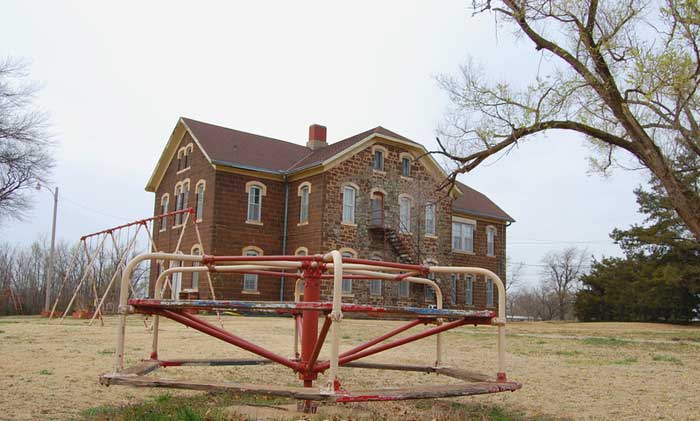
Abandoned school in Brookville, Kansas. Photo by Kathy Alexander, 2009. It has since been remodeled and converted into a private residence.
See Saline County Ghost Towns Photo Gallery HERE
© Kathy Alexander/Legends of America, updated October 2022.
Also See:
Emerging Ghost Towns of the Plains
Sources:
Blackmar, William; Kansas: A Cyclopedia of State History, Standard Publishing Co., Chicago, IL,1912.
Cutler, William; History of the State of Kansas, A.T. Andreas, Chicago, IL, 1883.
National Register of Historic Places – Elementary School
Wikipedia


